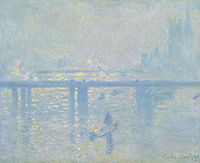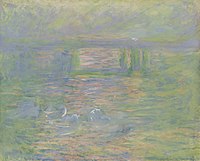
Oscar-Claude Monet was a French painter and founder of Impressionism painting who is seen as a key precursor to modernism, especially in his attempts to paint nature as he perceived it. During his long career, he was the most consistent and prolific practitioner of Impressionism's philosophy of expressing one's perceptions of nature, especially as applied to plein air (outdoor) landscape painting. The term "Impressionism" is derived from the title of his painting Impression, soleil levant, which was first exhibited in the so-called "exhibition of rejects" of 1874–an exhibition initiated by Monet and like-minded artists as an alternative to the Salon.

Pierre-Auguste Renoir was a French artist who was a leading painter in the development of the Impressionist style. As a celebrator of beauty and especially feminine sensuality, it has been said that "Renoir is the final representative of a tradition which runs directly from Rubens to Watteau."

Alfred Sisley was an Impressionist landscape painter who was born and spent most of his life in France, but retained British citizenship. He was the most consistent of the Impressionists in his dedication to painting landscape en plein air. He deviated into figure painting only rarely and, unlike Renoir and Pissarro, he found that Impressionism fulfilled his artistic needs.

Henri-Edmond Cross, born Henri-Edmond-Joseph Delacroix, was a French painter and printmaker. He is most acclaimed as a master of Neo-Impressionism and he played an important role in shaping the second phase of that movement. He was a significant influence on Henri Matisse and many other artists. His work was instrumental in the development of Fauvism.

Theodore Robinson was an American painter best known for his Impressionist landscapes. He was one of the first American artists to take up Impressionism in the late 1880s, visiting Giverny and developing a close friendship with Claude Monet. Several of his works are considered masterpieces of American Impressionism.

The Thyssen-Bornemisza National Museum, or simply the Thyssen, is an art museum in Madrid, Spain, located near the Prado Museum on one of the city's main boulevards. It is known as part of the "Golden Triangle of Art", which also includes the Prado and the Reina Sofía national galleries. The Thyssen-Bornemisza fills the historical gaps in its counterparts' collections: in the Prado's case this includes Italian primitives and works from the English, Dutch and German schools, while in the case of the Reina Sofía it concerns Impressionists, Expressionists, and European and American paintings from the 20th century.
The year 1899 in art involved some significant events.

Saint-Georges majeur au crépuscule refers to an Impressionist painting by Claude Monet, which exists in more than one version. It forms part of a series of views of the monastery-island of San Giorgio Maggiore. This series is in turn part of a larger series of views of Venice which Monet began in 1908 during his only visit there.
Claude Monet painted several series of nearly 100 impressionist oil paintings of different views of the Thames River in the autumn of 1899 and the early months of 1900 and 1901 during stays in London. One of these series consists of views of the Palace of Westminster, home of the British Parliament, and he began the first of these paintings at about 15.45 on 13 February 1900. All of the series' paintings share the same viewpoint from Monet's window or a terrace at St Thomas' Hospital overlooking the Thames and the approximate canvas size of 81 cm × 92 cm. They are, however, painted during different times of the day and weather conditions.

The Rouen Cathedral series was painted in the 1890s by French impressionist Claude Monet. The paintings in the series each capture the façade of Rouen Cathedral at different times of the day and year and reflect changes in its appearance under different lighting conditions.

The Kunsthal is an art space in Rotterdam. It opened in 1992.

Water Lilies is a series of approximately 250 oil paintings by French Impressionist Claude Monet (1840–1926). The paintings depict his flower garden at his home in Giverny, and were the main focus of his artistic production during the last thirty years of his life. Many of the works were painted while Monet suffered from cataracts.

The depiction of night in paintings is common in Western art. Paintings that feature a night scene as the theme may be religious or history paintings, genre scenes, portraits, landscapes, or other subject types. Some artworks involve religious or fantasy topics using the quality of dim night light to create mysterious atmospheres. The source of illumination in a night scene—whether it is the moon or an artificial light source—may be depicted directly, or it may be implied by the character and coloration of the light that reflects from the subjects depicted. They are sometimes called nocturnes, or night-pieces, such as Rembrandt's The Night Watch, or the German Romantic Caspar David Friedrich's Two Men Contemplating the Moon of 1819.
Thomas Agnew & Sons is a fine arts dealer in London that began as a print and publishing partnership between Thomas Agnew and Vittore Zanetti in Manchester in 1817. Agnew ended the partnership by taking full control of the company in 1835. The firm opened its London gallery in 1860, where it soon established itself as a leading art dealership in Mayfair. Since then, Agnew's has held a pre-eminent position in the world of Old Master paintings. It also had a major role in the massive growth of a market for contemporary British art in the late 19th century. Agnew's closed in 2013. The brand name was sold privately and the gallery is now run by Lord Anthony Crichton-Stuart, a former head of Christie's Old Master paintings department, New York.

The Fondation Claude Monet is a nonprofit that manages the house and gardens of Claude Monet in Giverny, France, where Monet lived and painted for 43 years. Monet was inspired by his gardens, and spent years transforming them, planting thousands of flowers. He believed that it was important to surround himself with nature and paint outdoors. He created many paintings of his house and gardens, especially of water lilies in the pond, the Japanese bridge, and a weeping willow tree.

Le Grand Canal is an oil on canvas painting by French Impressionist painter Claude Monet (1840–1926). It is one of six paintings looking down the Grand Canal towards the Salute church. This Grand Canal series is in turn part of a larger series of paintings of Venice which Monet undertook during 1908 on his only visit to the city. The artist is generally regarded by art historians as being at the peak of his powers at this period. The paintings were begun en plein air and completed in France.
Monet painted 37 works of Venice which he began during his stay in the city in 1908. These include a series of canvases of the Grand Canal. He had the habit of studying the same subject in a varying light, at different times of the day, which resulted during his career in many distinct series, like for example the Water Lilies series, Poplar series, Rouen Cathedral series, Haystacks series and Charing Cross Bridge series.

Ernest Ange Duez was a French painter of genre scenes, portraits, landscapes and religious subjects.

Waterloo Bridge is a series of 41 impressionist oil paintings of the 1807–1810 Waterloo Bridge in London by Claude Monet, produced between 1900 and 1904 and forming a sub-series within his larger 'London series' alongside the Charing Cross Bridge series and the Houses of Parliament series.
























